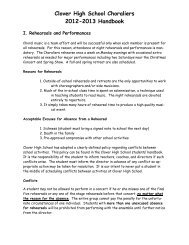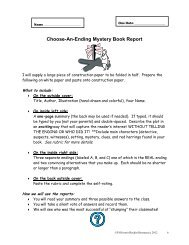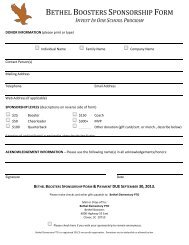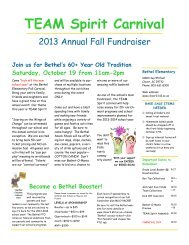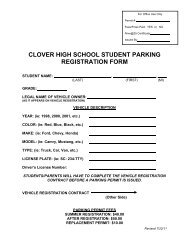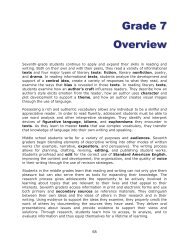Colonization Study Guide
Colonization Study Guide
Colonization Study Guide
You also want an ePaper? Increase the reach of your titles
YUMPU automatically turns print PDFs into web optimized ePapers that Google loves.
Test date__________<br />
Notes on Jamestown<br />
Jamestown 1607- Virginia<br />
Work done by poor- indentured<br />
servants<br />
Built on swampy land- bad farming,<br />
bad drinking water<br />
Hardships: illness, starving<br />
John Smith- great leader<br />
He got captured but saved by<br />
Pocahontas<br />
TOBACCO grew well and became<br />
first cash crop<br />
House of Burgesses was used for<br />
government<br />
Notes of Plymouth<br />
Plymouth- 1620- Massachusetts<br />
Pilgrims- religious freedom<br />
Mayflower got off course from storms<br />
Didn’t land in Jamestown<br />
No laws- made Mayflower Compactstart<br />
of democracy<br />
½ died- poor living conditions, disease,<br />
cold weather<br />
Then Samoset came and welcomed<br />
them. This began friendly relations<br />
between Native Americans and Pilgrims.<br />
Notes on The Lost Colony of Roanoke<br />
England’s first attempt of a colony was<br />
Roanoke Island<br />
Off coast of North Carolina<br />
Walter Raleigh sent a group there.<br />
Winter came and couldn’t find food<br />
They returned to England starving<br />
Raleigh sent John White with another<br />
group.<br />
Supplies ran out and White went back<br />
to England for more<br />
England was at war with Spain and he<br />
couldn’t return for a couple years<br />
When he got back to Roanoke,<br />
everyone had disappeared.<br />
No one knows what happened so it is<br />
called The Lost Colony.<br />
Notes on the first Thanksgiving<br />
Plymouth in 1621<br />
Made friends with Native American<br />
who spoke English<br />
Squanto showed them how to plant<br />
corn, beans, squash<br />
We are thankful for abundant fields<br />
overflowing with food<br />
We invited Squanto, Samoset, and<br />
Chief Massasoit to a feast of<br />
Thanksgiving.<br />
They brought 90 men<br />
We celebrated for 3 days!<br />
We ate fish, seafood, waterfowl, wild<br />
turkey, fruit, berries and squash<br />
Abraham Lincoln made Thanksgiving<br />
became a holiday in 1863
List the<br />
Colonies<br />
Religion<br />
Region<br />
(land, water,<br />
climate)<br />
Economy<br />
(how did they<br />
make money?)<br />
Important<br />
Facts<br />
New England Middle Southern<br />
Massachusetts Bay<br />
Connecticut<br />
Rhode Island<br />
New Hampshire<br />
Religious Freedom<br />
Pilgrims<br />
Puritans<br />
Rivers and streams not<br />
good for navigating but<br />
ran fast to produce<br />
power for mills<br />
Ship building<br />
Fur trading<br />
Fish<br />
whales<br />
Important building<br />
Meeting House in<br />
center of town for<br />
church and meetings<br />
New York<br />
New Jersey<br />
Pennsylvania<br />
Delaware<br />
Many religions<br />
Rivers<br />
Forests<br />
Rich farm lands<br />
Wheat by using wind<br />
mills to mill flour and<br />
ship to other colonies.<br />
Iron for tools<br />
Ship imports<br />
William Penn- Quaker<br />
who believed they<br />
should live peacefully<br />
with Natives.<br />
Ben Franklin- scientist,<br />
inventor, writer. 1 st<br />
book- Poor Richard’s<br />
Almanac<br />
Virginia, Georgia<br />
Maryland<br />
North Carolina<br />
South Carolina<br />
Catholics and<br />
Protestants for<br />
religious freedom<br />
Long growing season<br />
Mild weather<br />
Rich lands<br />
Lots of rain<br />
Cash crops<br />
Rice<br />
Tobacco<br />
Indigo- used to make<br />
blue dye<br />
Slaves were<br />
important here to<br />
work on plantations.<br />
Indentured servants<br />
also work- they<br />
agreed to work to pay<br />
off voyage to<br />
America<br />
What were the relationships among the<br />
Native Americans, Europeans and Africans<br />
during trade? Europeans needed Natives for<br />
communication and growing crops.<br />
Europeans needed Africans to tend to their<br />
crops. They were forced to work.<br />
How did this triangle trade impact the<br />
economy of North America?<br />
1. Provided plantation owners with skilled<br />
workers<br />
2. The slaves brought agriculture & mining<br />
skills learned in Africa to the Americas<br />
3. Made money from selling rum, tobacco,<br />
indigo and rice to Europeans in exchange for<br />
slaves




